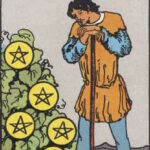The Major Arcana, a significant portion of the Tarot deck, consists of 22 cards that depict profound archetypes and pivotal moments in the journey of life. Each card, laden with symbolic resonance, invites both the seeker and the interpreter to delve into layers of meaning. From a Christian perspective, the Major Arcana can be interpreted through various lenses, reflecting personal growth, moral dilemmas, and spiritual enlightenment. This exploration seeks to address common observations in Tarot’s enigmatic allure while hinting at deeper resonances with Christian theology.
At its core, the Major Arcana provides a roadmap of the human experience, a narrative that transcends the mundane. The first card, The Fool, represents fresh beginnings and untapped potential. It is akin to the biblical themes of renewal and discovery, reminiscent of the journey of faith that begins with a single step into the unknown. Christians often identify with the notion of stepping out in faith, much like The Fool’s leap off the precipice, illustrating that the willingness to embrace uncertainty is integral to spiritual growth.
Transitioning to The Magician, one observes an embodiment of divine will and the manifestation of potential. He wields tools symbolizing the elements—earth, air, fire, and water—pointing to the idea that God equips individuals with talents and resources to fulfill their purpose. This card encourages believers to recognize their intrinsic abilities as gifts from God, empowering them to take actionable steps in their faith journey. The Magician thus bridges the corporeal and the celestial, inviting participants to harness their God-given strengths purposefully.
The High Priestess introduces the element of mystery. While she resides in the realm of intuition and the subconscious, Christians may perceive her as representing the Holy Spirit—an unseen guide in faith. The depth of her knowledge and the potency of her silence can be likened to the contemplative practices within Christianity, where silence often leads to profound insights. At this juncture, seekers are prompted to listen inwardly and discern God’s whispers, tapping into a reservoir of wisdom that transcends worldly understanding.
As we navigate through The Empress, we encounter themes of love, nurturing, and abundance—themes that resonate deeply within Christian lovingkindness and stewardship of creation. She represents fertility and expression of God’s lavish grace. In Christianity, this mirrors the notion of God’s providence, where believers are urged to care for the earth and one another, reflecting divine love through acts of service and compassion. The Empress serves as a reminder of the sacredness of life itself and the beauty in fostering relationships and cultivated communities.
The Emperor juxtaposes The Empress with authority and structure. Christians may see this as symbolic of God’s sovereignty, a reminder that divine order underpins the chaos of the world. The Emperor’s stern visage represents protective governance and moral guidance, akin to scriptural calls for righteous leadership. His presence advocates for obedience not only to earthly authorities but also to the heavenly one, offering an exhortation to uphold faith in the capacity of God’s kingdom to rule justly.
The Hierophant, representing tradition and spiritual guidance, resonates distinctly within Christian contexts. He advocates for adherence to established doctrine and communal worship, emphasizing the importance of community in understanding faith. This card might evoke reflections on biblical teachings and the sacraments as conduits of divine wisdom, encouraging individuals to seek unity within the church’s collective understanding while respecting the traditions that shape their beliefs.
The Lovers card, bathed in themes of union and choice, signifies deeper relationships—whether romantic or spiritual. From a Christian vantage, this card embodies the biblical narrative of companionship as a divine ordinance. It emphasizes love as a covenantal commitment rather than merely a fleeting emotion. Herein lies an invitation to reflect on the nature of relationships and the guiding principles of trust, fidelity, and the manifestation of God’s love through interpersonal connections. It differentiates between choice and obligation, reminding believers of their sacred duty to uphold love as a central tenet of faith.
When one encounters The Chariot, the narrative shifts towards triumph and the resilience of spirit. This card embodies the struggle between opposing forces, mirroring the Christian journey filled with trials and tribulations. It speaks to the steadfastness required to navigate life’s challenges, resonating with scriptural references that urge perseverance in faith. The Chariot symbolizes victory not merely through might but through the unity of heart and soul, highlighting the necessity of aligning one’s actions with divine purpose.
Further down the path in the Major Arcana, one encounters cards like Justice and The Wheel of Fortune, each delineating themes of moral responsibility and the cyclical nature of existence. Justice reaffirms the importance of ethical living per biblical teachings, while The Wheel of Fortune acknowledges the divine hand in the unfolding events of life. In a Christian framework, this card invites reflection on Providence—the belief that God orchestrates the events of our lives, guiding us toward spiritual awakening amidst life’s uncertainties.
The culmination of the Major Arcana is epitomized in The World, symbolizing completion and wholeness. This card signifies the attainment of spiritual enlightenment, echoing the rewards of faith—eternal life and the fulfillment of God’s promises. It serves as an encouragement for believers, reinforcing that every step taken in faith, every struggle endured, moves one closer to divine purpose and fulfillment.
In sum, the Major Arcana offers a compelling narrative replete with rich symbolism, echoing a myriad of themes that resonate with the Christian faith. Through understanding these cards, believers are beckoned to explore the nuances of their spiritual journey, reflecting on personal evolution, spiritual responsibilities, and the collective narrative of love and redemption. Ultimately, the exploration of the Major Arcana from a Christian perspective unveils a path anchored in faith—an invitation to seek deeper communion with the divine throughout life’s labyrinthine journey.









Leave a Comment